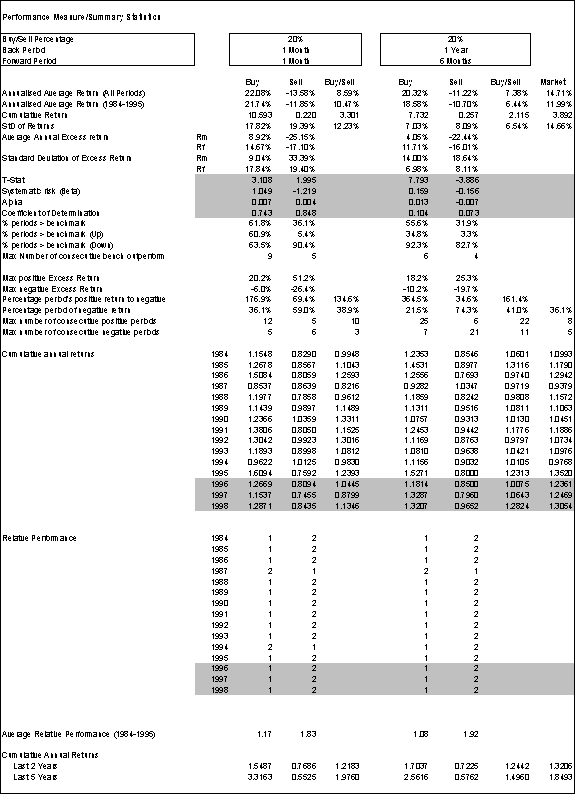Use
of Momentum in trading across Industry Sectors
Prepared by: Plein de Fric
![]()
Yuri Krapivin
Yuk Ping Ng
Pierre Oustinow
Jonathan Steinmetz
Terence Tong
Stage 1 – Identify momentum effects
in the S&P sub-index.
Model 1A – Base Model: 4 Quartile
Model
Model 1B – Maximum Return Model
Model 1C – Sustainable Return Model
Stage 2 – Optimized Momentum Models
Model 1A – Base Model: 4 Quartile
Model
Model 1B – Maximum Return Model
Model 1C – Sustainable Return Model
Further Areas of Suggested Research
Overview
Price momentum is a market-based trading strategy that seeks to use publicly-available information of previous prices, returns and/or trading volume to extract abnormal returns. Numerous research have been performed in a variety aspects of this type of strategy, particularly for baskets of individual stocks.
Within the momentum trading strategies, it is worthwhile noting that the duration of holding period will influence the type of strategy that should be employed. They are summarized as follows:-
- Short-term horizon [under three months]: Studies indicate that prices reverse over short intervals. This phenomena seems to be attributed to cross-sectional autocorrelations in returns and transaction costs.
- Medium-term horizon [Three to twelve months]: During this holding period, there is evidence of momentum-driven outcomes. Past winners have a tendency to outperform past losers over the subsequent three to twelve month interval. Investor under-reaction appears to be the most likely explanation for the momentum effect.
- Long-term horizon [three to five years]: It is generally suggested that contrarian strategies are successful in earning abnormal returns over a long time horizon. Long-term losers tend to outperform long-term winners over the subsequent three to five years. Returns tend to mean-revert on a longer time horizon. Plausible explanations include investor over-reaction, market microstructure biases and time-varying returns.
Objective
In this paper, we examine the characteristics of returns momentum in the sub-indices in the Standards and Poor 500 (S&P500) using sorting screens over a combination of holding durations. Our data set comprises of total period returns between the period of January 1980 and March 2000. During this period, over 130 sub-indices have evolved.
After determining the presence of momentum effects in the sub-indices, we then examine two methods of optimizing the momentum trading strategy. The first is to device a knock-out mechanism to remove “weak” momentum sub-indice contributors to portfolio returns. The second is to optimize the weights on sorted portfolios to see if we can diversify risk and increase actual returns.
This exercise has implications on the asset management industry because many fund managers have to make top down decisions on the weights to place and each sector and a strategy that is able to give some predicative powers could prove profitable.
Methodology
Stage 1 – Identify momentum effects in the S&P sub-index.
In our model, we perform univariate sorts on the S&P sub-indices based on the past total gross period returns, from highest to lowest. The length of the period, for which the return is calculated, can range from 1, 3, 6 and 12 months. We measure the portfolio outcomes using 1, 3, 6 and 12 months holding period. Next, we select the sub-indices that performed best in the past period and include them in the ‘buy’ portfolio. Conversely, the sub-indices that performed worst go into the ‘short-sell’ portfolio.
Essentially, we consider different backward and forward periods with the aim to select an optimal combination of those periods, so that our portfolio delivers the highest return with a relatively low level of risk. We form a rolling-over position whereby a new position is formed every month in order to obtain the average returns for the portfolio combinations. Also, we form equal weighted longs and shorts so that there is no initial capital outlay. Lastly, we vary the fractile size and set different selection criteria to study the various behaviors of our long-short portfolio returns under these predetermined conditions.
The in-sample period runs from Jan 1984 to Dec 1985 for portfolio selection. After that, an out-of-sample return between Jan 1996 to Mar 2000 is computed to see how the portfolios fare.
Model 1A – Base Model: 4 Quartile Model
In Model 1A, we divided the sorts into four quartiles with the objective to identify momentum effects in the S&P sub-index. This model was used to validate the existence of a momentum effect.
Model 1B – Maximum Return Model
In Model 1B, we examined various fractiles and selected the combinations of lookback and holding periods that allowed us to maximize our long-short portfolio returns.
Model 1C – Sustainable Return Model
In Model 1C, we reexamined the various fractile combinations and attempted to look for a balanced and sustainable model based on returns, standard deviation, sharpe ratio, percentage number of positive/negative return periods, and maximum loss for a period.
Stage 2 – Optimized Momentum Models
In this stage, we attempted to optimize the returns on Model 1C by utilizing a knock-out feature, and by optimizing based on the MVF optimization to obtain an efficient frontier.
Model 2A – Knock-Out Option
We implemented a knock-out option as we thought that it was possible that some stocks were not sensitive to the momentum effect and thus, by eliminating them, we could increase the efficiency of our momentum strategy. Thus, we implemented an option whereby we knocked out those stocks that did not display a big momentum effect.
This was achieved by first picking the top X% (we used 20% as base case) of stocks to buy and sell for each month. Then, we ranked the returns of these stocks. For the buy portfolio, if they fell within the top Y% (we used 60% in the base case), we called it a ‘successful buy’, likewise if a sell stock fell within the bottom Y%, we called it a ‘successful sell’. We then chose to evaluate the stock’s performance over the past 5 years. If a stock was either a ‘successful buy’ more than Z% (60% in our base case) of the times it was bought, or a ‘successful sell’ more than Z%, then it would be kept, otherwise, they were knocked-out. After this knock-out was effected, we have a reduced list. The returns on this reduced list would be ranked again and the buy and sell portfolio formed out of this reduced list.
Model 2B – MVF Optimization
In Model 2B, we used past five year portfolio monthly means, standard deviations and covariances to determine optimum weights for investments in the following period. The previous models confirmed that the sorting screens had some ability to predict winners and losers for the next periods momentum-driven sub-index asset classes. Hence, we hypothesized that the combination of several portfolios with different lookback and holding periods could be optimized so that we can achieve excess returns over the portfolio with the lowest standard deviation, ie constrain the optimization to the portfolio with the lowest standard deviation.
Observations
Model 1A – Base Model: 4 Quartile Model

From our base model of 4 quartiles, we note that the 1m lookback/1m holding period (25%-1-1) and the 12m lookback/6m holding period (25%-12-6) portfolios showed the strongest evidence of momentum. The average ranking of the top and bottom quartile shows that these portfolios are reliable. The smaller the average ranking of the top quartile is from 2.5, the more reliable is the momentum effect. Conversely, for the bottom quartile, the larger the average ranking is away from 2.5, the more reliable is the momentum effect.
Summary Results

From the in-sample results, we notice that while the 25%-1m-1m portfolio had higher returns as compared with the 25%-12m-6m portfolio, the latter had a higher sharpe ratio and greater success in picking positive periods. This suggests that the 25%-12m-6m portfolio provides more reliable returns, and is consistent with our intuition. This observation is confirmed in the out-of-sample observations where the latter portfolio performance was superior to the former.

Model 1B – Maximum Return Model

Next, we wanted to optimize the fractile size (weights) so that we could
optimize on returns. This led to the
selection of a 20 fractile (long 5% top/short 5% bottom). Two portfolios, being 5%-1m-1m and 5%-12m-6m
were identified as having superior in-sample performance.
Summary Results

While the mean returns are superior to that of the base model, the volatility is not compensated for, as reflected in the lower sharpe ratios. Also all the statistics are inferior to the base model. The most important criteria is that the out-of-sample results were worse off. This is probably attributed to concentration risk in selecting small fractiles, resulting in non-sustainable performance.
Model 1C – Sustainable Return Model

Next, we set our objectives to define a more sustainable model. We used additional selection criterias of sharpe ratio, maximum loss in a period and the percentage number of positive returns divided by the number of negative returns to build reliability into the model. This led to the selection of a quintile (5 fractiles) sorting. We filtered out selections that suggested shorter lookback period for longer holding periods. As an example, while the table above suggests that we should adopt a portfolio which looks back 3 months and has a holding period of 12 months (20%-3m-12m), we find this to be a random outcome that is not sustainable. Once again, the 20%-1m-1m and 20%-12m-6m portfolios prevailed as the preferred portfolios.

Compared with the base model, the in-sample outcomes were mixed. Yet the out-of-sample returns were superior in most cases. So we decided on a qualitative basis that this quintile sort with the 20%-1m-1-m and 20%-12m-6m portfolios is the best of the three models. As such we will use this model as a basis for comparison in the next level of optimization exercises.

Model 2A – Knock-Out Option

The results show that in sample, we have achieved a higher return. However, this came at the expense of a higher volatility and the Sharpe ratio actually falls. This seems reasonable as with knockout, we are picking the sectors that have a tendency to have greater price movements. At the same time, we are buying portfolios with fewer sectors. However, going out of sample, we found that returns actually fell. This suggests that perhaps the sectors that are most demonstrate the momentum effect are not consistent over time since otherwise, we should be adding to our predictive powers.
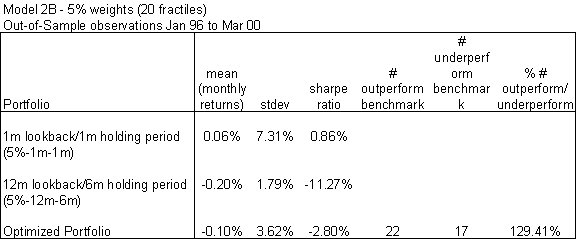
Model 2B – MVF Optimization
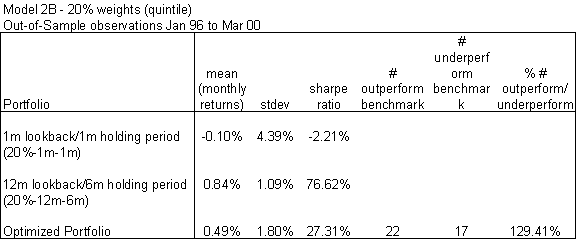
In this optimization exercise, we took the two portfolios and attempted to optimize the weights for the following investment period using the mean-variance frontier optimization. We have thus confirmed that the sorting screens had some ability to predict winners and losers for the next periods momentum-driven sub-index asset classes. Hence, we hypothesized that the combination of several portfolios with different lookback and holding periods could be optimized so that we can achieve excess returns over the portfolio with the lowest standard deviation, ie constrain the optimization to the portfolio with the lowest standard deviation. However, the out-of-sample returns for both the 20 fractile and quintile sorts placed the “optimized” portfolio outcomes between the original portfolios. The probable reason for this outcome is that we were using contemporaneous means, standard deviations and covariances as inputs for the optimization process.
Conclusion
The overall conclusion is that momentum strategy on industry sectors delivers significant positive results under certain conditions. Our general findings can be summarized as follows:-
- Longer lookback and holding period sorts produce more reliable returns that are sustainable over the longer term. In this study, a 12 month look back and a 6 month holding period (20%-12m-6m) appears to be optimal. This is consistent with our intuition that investors under-react to information over the medium term (3 months to 1 year), thus justifying the 12 month look back. Also, returns are smoothened out when we have a longer holding period.
- Shorter lookback and holding period sorts may result in higher in-sample returns, but have to contend with high trading volume, which reduces the returns due to transaction costs. The 1m-1m portfolios tended to have highest in-sample returns, but performed relatively poorer out-of-sample.
- Large fractile sorts result in portfolio concentration, and will not yield consistent results because they do not benefit from portfolio diversification. In purchasing a sub-index portfolio, we are in effect narrowing our stock selection to firms that have high correlation with each other. Increasing fractile sort sizes (ie. Dividing the sub-index into more fractions) will cause our portfolio to invest in less numbers of sub-indices and accentuate the concentration risk. In our case, with the S&P500 subindices, we found a quintile sort to produce the most reliable outcomes.
Further Areas of Suggested Research
Based on our findings, we believe that the subject of optimization of return-based momentum models warrant further research. While our attempt at optimization did not produce the desired outcomes, we believe that a further probe in the suggested directions below may uncover more valuable trading strategies. Our spreadsheets have been developed with great flexibility to assist in the process. The additional areas of research are as follows:-
1. Calculate the market exposure of our trading strategy so that we can improve on the risk management aspect of this strategy.
2. Perform the momentum sorts over other time periods to see if the momentum effect is noticed over longer time horizons.
3. Perform momentum sorts on other asset classes or markets to see if the momentum effect occurs.
4. Device an on/off trigger to determine when not to trade on a momentum strategy.
5. Tweak the knock out effect to find the best knock out variables to see if we can implement a “knock-out” system that give us higher returns and lower volatility.
6. For Model 2B, the optimized weights can be used to create an optimized scoring sheet. Two portfolios of the same holding period, say 20%-6m-6m and 20%-12m-6m can be viewed as two attributes of a momentum univariate sort. The optimized weights can be multiplied with the sub-indice rankings based on the two attribute univariate sorts. The sum of the weighted ranks can then be resorted. We then long the top quintile and short the bottom quintile.
Appendix
Model 1A – 4 quartile 1m lookback/1m holding period Output
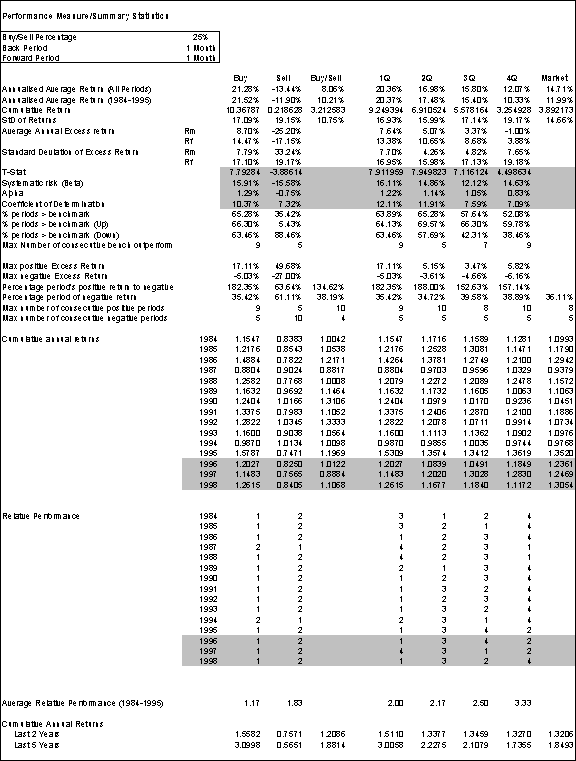
Model 1A – 4 quartile 12m lookback/6m holding period Output
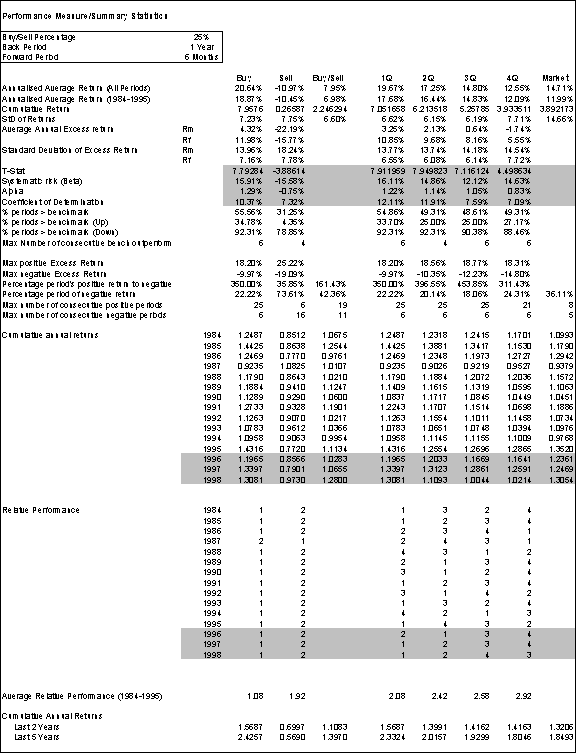
Model 1B – Maximize Returns
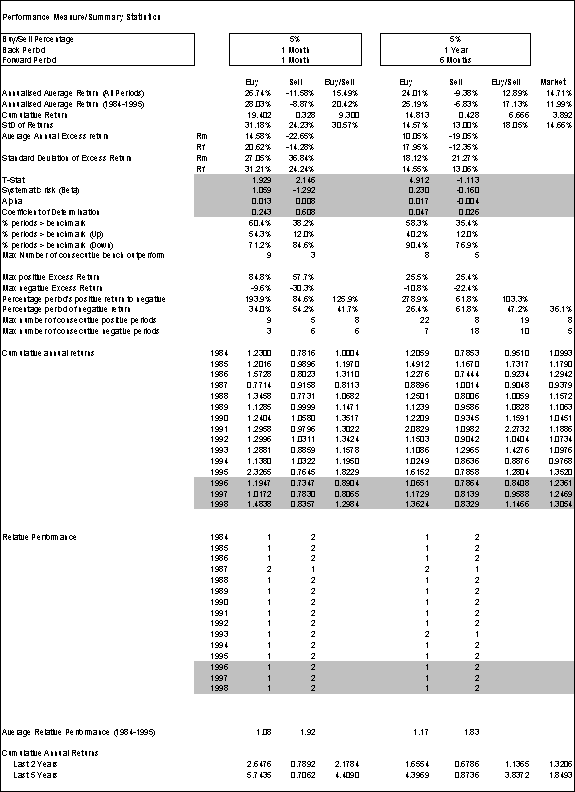
Model 1C – Balanced Portfolio
